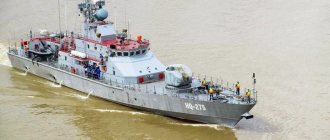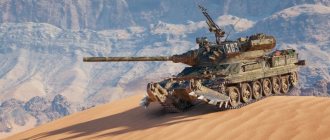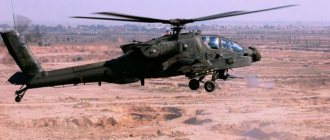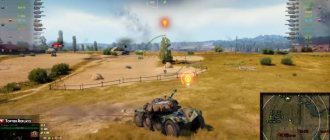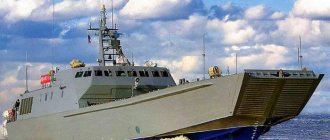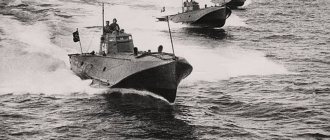The Project 03160 Raptor patrol boat was first launched in mid-August 2013. This fast boat was made specifically for the Russian Navy at the Leningrad Shipbuilding Plant. The “donors” were the Swedish Combat Boat 90 boats (in its civilian modification), which were purchased by Russia in the period from 2004 to 2012 in the amount of 11 pieces. Since Sweden sold Russia only commercial versions of patrol boats, devoid of armor and weapons, it was decided to create their own version of an armored patrol boat on their basis.
As of 2015, the Russian Navy received 8 units of Raptor fast patrol boats, and in the period from 2016 to 2020, the shipyard committed to supply the fleet with more than 10 boats of Project 03160. Raptor fast patrol boats are currently the fastest military boats in Russia.
Project history 03160
In the Soviet Union, starting from the late 60s, close attention was paid to the development of small patrol boats designed for the following purposes:
- Interception and detention of surface targets that violated the borders of the territorial waters of the USSR;
- Patrolling water areas;
- Defense from the sea of naval bases from various types of sabotage;
- Carrying out search and rescue operations.
For these purposes, the Grif patrol boat, developed as part of Project 1400, was designed in 1967 and put into production in 1969. These 36-ton patrol ships at that time fully corresponded to their tasks. Over the years of production, which continued until 1990, about 300 boats of this series were produced. They were produced at three factories:
- PA "Almaz";
- Software "Sea";
- Batumi Shipyard.
In Ukraine, the construction of Grif boats continued in the 1990s.
Although about 100 Grif boats are still in naval service, they became morally and physically obsolete in the late 1980s. The rather worn-out boats, capable of reaching a speed of 29 knots, were significantly inferior in their characteristics to their foreign counterparts. Back in the late 80s, it was planned to launch a new project to create a more promising model of a combat patrol boat, but the collapse of the Soviet Union prevented the implementation of these plans.
For a long time, this niche remained unfilled, since funding for the Navy was practically stopped in the 90s. Only in the late 90s, at the shipbuilding plant in Rybinsk, a new high-speed patrol boat “Mongoose” was developed, created as part of Project 12150. This boat, which began mass production in 2000, could accelerate to 53 knots, which is compared to the speed of outdated "Grifov" was a real breakthrough.
However, the Mongoose speed boats did not quite correspond to the Russian IMF’s idea of an ideal patrol boat. In their opinion, such a boat should have the following characteristics:
- Availability of a ramp for landing;
- Serious weapons on board;
- Light hull armor;
- Small draft of the vessel.
The fast patrol boats "Mongoose", despite their outstanding speed performance, were boats of a slightly different class.
Combat use
Despite the construction and delivery of large keelboats, coastal gliders remained the basis of the Soviet mosquito fleet until the end of the war. Including the Komsomolets torpedo boats. The war showed that views on the combat power of torpedo boats turned out to be overly optimistic. This did not mean that they were useless; on the contrary, Komsomols and their analogues were actively used in supporting roles.
For example: they destroyed minefields using depth charges, or laid mines themselves. They landed reconnaissance groups in the rear and used them as landing craft. Well, their main task within the framework of their “main specialty” was to attack transport convoys and ships in parking lots.
In their combat missions, the torpedo boats initially used “free search” tactics, in which they plowed the specified areas until they reached enemy ships.
Gradually, in order not to overload the ships with additional fuel, depriving them of maneuverability, the sailors began to switch to ambush tactics, waiting for convoys at the approaches to their base (most often this was done in the Northern Fleet). In the case of Komsomolets, the scope of application of ambush tactics was limited to a small range, which did not allow transitions to remote bases.
But the most striking episode in the combat career of Project 123 boats is associated with the use of raid tactics. In the spring of 1945, two Komsomolets, using air reconnaissance data, secretly approached the Hel Spit, where they discovered the destroyer Z-34. Having hit the target with 2 torpedoes, the Komsomols left under the cover of a smoke screen. The hit disabled the destroyer's turbines and deprived the ship of electrical power. The next day, the Z-34 was towed away for repairs.
Another famous case is the attack by three Komsomols on a convoy in Danzig Bay. Torpedoes managed to hit 2 landing barges armed with artillery. The TK-135 boat, damaged during the attack, was evacuated and taken in tow. In general, the conquest of air supremacy by Soviet aviation increased the effectiveness of the mosquito fleet, providing the possibility of joint raids by boats and torpedo bombers.
The post-war Komsomolets - Project 123K ships - were exported to regimes friendly to the USSR.
It is likely that Chinese boats were used during the conflict between Communist China and Taiwan. In addition, the Chinese themselves mastered the production of P 4 boats of a similar design, which were used by the PLA Navy until the 90s. The PRC, in turn, also supplied “P 4” to possible allies, for example, to North Vietnam.
Immediate predecessors of the Raptor series boats
Since the domestic defense industry could not at that time provide the Russian Navy with high-speed patrol boats. A decision was made to purchase vessels of this class from Sweden. Between 2004 and 2012, 11 Combat Boat 90 boats were purchased from Dockstavarvet, which differed from their military modifications in the lack of armor and weapons.
Swedish military boats have been produced since 1991. Currently there are about 250 boats of this model. They are widely used in the Navy and law enforcement agencies of the following countries:
- Sweden;
- Norway;
- USA;
- Mexico;
- Greece;
- Brazil and many other countries.
Its combat capabilities have been repeatedly tested during numerous combat operations around the world.
Although there is no direct mention of this, there is no doubt that the Russian patrol and landing boat Raptor is a significantly improved modification of the Swedish Strb 90H boat. The main differences between the Russian development and the original are as follows:
- Increase in size;
- More modern equipment;
- Installation of more modern and powerful engines, which significantly increased the speed characteristics of the Russian model;
- Installation of a more powerful machine gun. Most machine guns installed on Swedish patrol ships have a caliber of no more than 12.7 mm. The Russian Raptor has a more powerful 14.5 mm machine gun;
- The armor of the Russian patrol ship is significantly superior to the standard armor of the Swedish military boat.
That is, currently the Russian development is significantly superior to its Swedish counterpart in almost all indicators.
Several Swedish boats were transferred to the federal security service in Moscow. In 2013, they became part of the Russian Navy. It is a widely known fact that Swedish boats were widely used during the Winter Olympic Games in Sochi. In 2014, the boats were transferred to Sevastopol, where they were widely used to ensure the security of President Vladimir Putin, who visited this city on May 9, 2014.
Since it was too expensive to create a patrol boat based on the Grif or Mongoose, it was decided to create the Raptor project based on Swedish ships, which were designed specifically as high-speed patrol boats.
River combat fleet: protecting inland waterways
The Swedish combat boat Combat Boat 90H is being tested on the Amazon River.
This model has proven itself very successfully in coastal maritime and river operations. The market for river vessels designed to solve military and security problems is very diverse, with a fairly wide range of different models available.
While most focus on small special forces and fast patrol boats, Colombia, which has the most experience in this field, also relies on medium armored vessels to support its small boats. As for river operations, here some fleets and shipyards have extensive experience, because many conflicts often took place in territories with large rivers of strategic importance. During the Cold War, the Vietnam War became the epicenter of attention, and the Mekong River became the main backdrop for such operations. Experience has been gained and even applied by some countries, as a result of which the need for fast and/or well-protected ships has increased. For assault, patrol and special operations, high-speed maneuverable boats with protection and moderate firepower were needed; Larger, well-protected vessels are needed for support. At the moment, they can be divided mainly into four groups: rigid-hull inflatable boats; light ships with rigid hulls; medium river ships and hovercraft.
Riverine operations are common in asymmetrical conflicts, mainly in counterinsurgency warfare. Sailing close to shore where the enemy can easily hide, slow-moving vessels are very vulnerable to ambush and require better protection, armor, heavy weapons and the "escort services" of smaller boats.
It goes without saying that the main river fleet is operated by countries with large rivers plus the US Navy (where to go). However, many coastal vessels used for other tasks could be suitable for river operations, having flat hulls, high speed, good maneuverability and other useful properties. Most countries still operate obsolete vessels (some donated), including relics of the Vietnam War, as is the case with Thailand and Venezuela. Others operate antique vessels, 70 years or older, and some rely on non-military platforms with light or no weapons, often suitable only for logistics. Finally, some of the vessels described below have a dual purpose, operating on the high seas and in closed waters.
The 25th Boston Whaler cutter Guardian serves in the Colombian Marine Corps. Guardian boats are widely used in the navies and marines of many countries around the world.
USA. Out of many one
Among American manufacturers offering a variety of light-duty vessels for a variety of purposes, SAFE shipyard boasts a wide range of patrol boats operating in various fleets.
Among them are three boats specially designed for river operations. The multi-mission RPB (Riverine Patrol Boat) platform is designed to provide tactical mobility and fire support for river and coastal operations in contact with the enemy. It has a flat bottom hull, twin inboard diesel engines, two water jets, a power operated bow door, machine gun mounts and optional armor. The completely enclosed RCB (Riverine Command Boat) platform is designed to conduct operational control and fire support operations on inland waters and on the coastline in combat conditions. The platform is based on the Swedish Combat Boat 90, of which the US Navy operates six.
A larger version of these platforms is the next-generation Mk VI PB patrol boat, part of the US Navy Expeditionary Forces Sustainment Command fleet, its deliveries began in 2014. The 26-meter-long vessel's mission is to provide combat commanders with the ability to patrol shallow coastal areas. The boat is equipped with two diesel engines and water jets, which at full load allow it to reach a speed of more than 30 knots.
The Brunswick Group, one of the most successful suppliers of light river patrol vessels in recent years, has sold its boats to many countries. From the Boston Whaler GUARDIAN (4.6-8.2 meters, with a choice of engines, weapon mounts, seats) and larger JUSTICE series boats (several options, 6.1-11.3 meters) to the IMPACT RIB fast boats, D-COLLAR and SENTRY with aluminum housings.
Swiftships builds specialized river vessels, selling large numbers of them to Africa and Latin America. Currently, its main river platform is the aluminum boat ANACONDA SOCR (Special Operations Craft Riverine) with diesel engines and two water jets, reaching speeds of over 50 knots. It can carry 6-14 people in full gear, has a bow ramp, and can accommodate up to five machine gun mounts. The larger RAC (Riverine Assault Craft) boat, 11 meters long, is in service with the US Marine Corps, it has similar design characteristics: it can carry 15 fully equipped soldiers and has ballistic protection in accordance with Level 3a.
Metal Shark has also designed a range of platforms specifically for riverine operations, with the rugged, shallow-draft 21 and 24 Riverine patrol boats able to withstand harsh operating conditions. The Model 24 Riverine is manufactured for customers from the US Department of Defense and is currently operated in Latin America, performing border security and counter-drug trafficking missions. The Model 24 is equipped with a Yanmar 415 HP diesel engine and a Hamilton 274 water jet with integrated cooling system and hydraulic thrust reverser.
Israel Shipyards' Shaldag MkII patrol boat has been in service with the Argentine Coast Guard since 2022
Willard Marine also offers a variety of river patrol vessels in 6.7, 8.2 and 9.1 meter lengths. The first two have fiberglass hulls and outboard engines, while the third is made of aluminum and has an inboard engine.
The Silver Ships shipyard (Mobile, AL) also has in its portfolio small high-speed patrol vessels, of which the AMBAR series is best suited for river operations: depending on the model and configuration, the length varies from 6.1 to 20 meters and engine power from 300 to 1400 hp
To meet the modern battlespace, Suncraft has developed a line of fast patrol and interception craft, including the MANTA MKII ASD, PIRANHA ASD and RAPTOR. The multi-purpose boat RAPTOR SWOC (Shallow Water Operating Craft) with a length of 13 meters meets the requirements for shallow-draft landing craft. The basic configuration includes two MAN diesel engines with 550 hp each. each, which allows you to reach a maximum speed of up to 35 knots with half the load.
Arkansas-based SeaArk also builds a wide line of small river vessels for civil and military applications that are operated by the U.S. Navy and other foreign navies. The main military product is designated DAUNTLESS 34; more than 120 of these vessels were delivered to the Navy.
United States Marine, Inc. Shipyard (USMI) has delivered 12 Riverine Assault Boats (RAB) 10 meter long river boats to the US Navy. They are made of aluminum and equipped with two Yanmar 6LY2A-STP diesel engines with 440 hp each. and two Hamilton HJ292 water jets, allowing a speed of up to 40 knots. The boat accommodates six people, while the Special Operations Craft Riverine (SOCR) model, based on the same hull, can accommodate up to 8 passengers. The company also offers an 11-meter Naval Special Warfare RIB with two Caterpillar or Cummins QSB 6.7 diesel engines and KaMeWa or Rolls Royce water jets.
Safehaven Marine's BARRACUDA during testing. The boat can be equipped with various weapons on the roof of the wheelhouse and the rear deck
European fairway
Swedish shipyard Doksta Varvet is a major manufacturer of river and coastal patrol boats, and many countries have bought its successful Combat Boat 90H platform.
This fast landing craft with an aluminum hull heavily reinforced for landing on unprepared shores (with a narrow bow ramp) is capable of carrying 20 soldiers and cargo at speeds of more than 20 knots. In addition to boats built for the Swedish and Malaysian navies and manufactured under license in the USA, there are also special versions for the Greek, Malaysian and Mexican navies. The Mexican shipyard Astimar built them under license and developed improved variants, such as the ACUARIO and POLARIS II. The vessel is equipped with two Scania DSI 14,460 kW diesel engines and two KaMeWa FF water jets. The weapon system includes a 12.7 mm machine gun or a 40 mm grenade launcher on the turret and a twin 12.7 mm machine gun in front at the helm. In addition, the SV 90N boat can take on board 2.8 tons of mines or a modified RBS 17 missile system of the HELLFIRE type. The 12.7 mm manually loaded machine gun can be replaced with stabilized remote-controlled weapons. The possibility of installing a double-barreled 120-mm AMOS mortar system is currently being explored.
The Spanish shipyard Asis in its portfolio has various models of semi-rigid boats for river operations with aluminum hulls and inflatable seats with a length of 8, 9.5, 12 and 12.5 meters, which are capable of accepting up to two 12.7 mm machine guns, and on the largest models can accommodate up to 15 seats. Depending on the model, outboard or inboard engines can propel the boat up to 70 knots. Another Spanish company, Rodman, produces a series of light patrol vessels for coastal and river operations, including models 38, 55 and 111.
The Irish shipyard Safehaven Marine offers a coastal and river version of the high-speed amphibious assault vessel BARRACUDA, capable of carrying up to 16 soldiers, who are placed on shock-absorbing seats. Water-jet propulsion and a shallow draft of 75 centimeters allow it to perform tasks on rivers and inland waters, as well as in coastal waters. You can install two types of main weapons: either an open turret with a 12.7 mm machine gun/40 mm grenade launcher, or a turret with drives with a 7.62 mm machine gun. Removable supports are installed on the aft deck and allow the installation of additional machine guns of 7.62 mm or 12.7 mm caliber. The landing ramp is located in the bow.
The French shipyard Raidco Marine produces a wide variety of patrol boats for river operations, from rigid-inflatable boats with a length of 2.24-3.35 meters to rigid-hulled vessels with a length of 3.6-11 meters.
Damen in its portfolio also has a line of rigid-hull inflatable boats with a length of 7.5-12 meters with outboard and inboard engines, these are models designated RHIB 750 to 1200. It also offers rigid-hull boats with a length of 10.9 and 14, 5 meter interception made from aluminoborosilicate alkali-free glass and carbon fiber reinforced epoxy.
The 10 meter Fassmer SFB 10.1 rigid hull inflatable boat accommodates up to 15 people, has a deep v-hull for optimal performance, flexible seating and a center steering console. The body is made from high quality composite materials and features a multi-chamber inflatable bladder with a sliding mount for easy section replacement.
The Italian company RB Design manufactures a variety of rigid-hull inflatable boats and rigid-hull boats for coastal and river operations ranging from 3 to 24 meters in length, many of which have already been supplied to a number of fleets.
Lurssen's FIB 25, designed for onshore operations, can also be used for riverine missions; has a draft of 1.2 meters and a length of 27 meters, and thanks to two diesel engines and two water jets, the boat can reach speeds of up to 40 knots.
The Halmatic shipyard, now part of BAE Systems, produces a line of fast inflatable boats for river and special operations, plus a rigid-hull boat for assault teams. The latter has two versions, 5.2 and 6.5 meters in length, both of which are used by the British Navy; while the line also includes the Pacific 24 and 950, the latter designed for special forces. BAE Systems also builds Combat Support Boats for the British Army, designed for shallow waters.
The photo shows the patrol boat PAF-P of the Cotecmar shipyard of the Colombian fleet with a Bell 212 helicopter landing on it. Based on this project, together with the Brazilian Emgerpron and the Peruvian SIMA, the company is developing a new vessel
Latin American Way
In Colombia, the Cotecmar shipyard has extensive experience in building river vessels for the Colombian and Brazilian navies.
There are three flagship platforms in the line. The first, designated LPR 40, is a 12-meter-long fast patrol vessel made of aluminum. The boat has a closed wheelhouse and is armed with three 12.7 mm (or two grenade launchers) and two 7.62 mm machine guns, equipped with twin engines and two water cannons. The second model, the 30-meter-long light support boat PAF-L, accommodates a crew of 14 and 28 paratroopers. Finally, the 40.3 meter PAF-P is designed to support larger fleets of small vessels. It has a crew of 31, can accommodate 39 soldiers, has a helipad and a small medical cabin with four seats. The weapon system includes four M60 machine guns, three coaxial 12.7 mm machine guns and one grenade launcher. In Brazil (Emgepron) and Peru (SIMA), the patrol boat Patrullero Amazonico, armed with a 25-mm cannon, a grenade launcher and four 12.7-mm machine guns, is being developed for the fleets of all three countries based on the PAF-P model. The length of the vessel is 53.1 meters, among other things, it can transport a standard 20-foot container.
The Peruvian SIMA has already built two 43.5 meter long river vessels for the Peruvian fleet, these vessels have a crew of 29 people and a passenger capacity of 20 people.
Another Colombian shipyard, Eduardoho, also builds light river patrol boats (models 195, 260, 320, 380 and 480), all operating in the Colombian fleet and the navies of several Central American countries, including Costa Rica and Panama. The 6-meter-long Model 195 is equipped with two outboard engines and racks for one 12.7 mm and two 7.62 mm machine guns; Models 260 and 320, also with two outboard engines, 8 and 10 meters long, respectively, can take on board two 12.7 mm and four 7.62 mm machine guns. The 380 is 11.5 meters long and has three engines. The largest model, the 480, is 13.6 meters long and has an enclosed deckhouse and is powered by three outboard engines.
The Argentine shipyard TECNAO produces rigid-hull patrol boats TORO and YAGUARETE, respectively, with inboard and outboard engines and water jets, allowing them to accelerate to 32 knots; These boats were supplied to the Argentine Coast Guard.
The patrol boat TORO, built by the Argentine shipyard TECNAO, participates in river operations of the coast guard of this country
Asia big and small
Israel is the main regional manufacturer of light patrol and river vessels.
Two companies in the country, Israel Shipyards and Israel Aerospace Industries, build ships to their own designs. IAI's DVORA class boats have now received the latest addition in the form of the SUPER DVORA MkIII, which like other models (although the current focus is on coastal operations) can also participate in river operations. The boat has a draft of 0.9-1.3 meters, a hull length of 20-29 meters and maximum speeds of over 40 knots. Israel Shipyards' SHALDAG series boats are also primarily designed for offshore operations, but the four MkII boats sold to the Argentine Coast Guard, for example, are used in riverine missions. They are armed with a Browning M2A2 machine gun in the MINI TYPHOON turret and two 7.62 NEGEV machine guns on the bridge. On the other side of Asia, the Taiwanese company Lungteh specializes in rigid-hull inflatable boats and rigid-hull interception boats, perfectly tailored for river operations. A large number of boats were sold to the fleets of Asian countries, where the inflatable model with a length of 12.9 meters is especially popular.
As for hovercraft used in river operations, the vessels of the British company GRIFFONHOVERWORK are particularly popular, they were bought by the navies of India, Colombia and Peru. The latter two use the 2000TD model in the fight against partisans. The vessel can be armed with several machine guns and can accommodate up to 18 soldiers. The British Marines have recently taken delivery of the more modern and powerful 2400TD series vessels, which are primarily used in coastal areas.
Purpose of the Raptor boats
Raptor fast assault boats are designed to perform a wide range of missions. They can work effectively both in daylight and in the dark. The design of the patrol boat provides it with excellent speed and the ability to move through the sea even in seas up to 5 points inclusive.
The boat is capable of carrying up to 20 paratroopers in full gear. This feature allows it to be used for targeted airborne strikes. The patrol boat's armament is capable of providing fire support to the landing force, as well as providing cover for it during retreat. In addition, the Raptor patrol boat is capable of providing security for ship bases or escorting commercial and scientific vessels in dangerous areas.
Since the hull of the high-speed patrol boat is made of aluminum, it is not susceptible to corrosion. Thanks to special equipment, the boat can perform combat missions at a distance of 100 miles from its base.
River military boats
For the war in the Mekong Delta and other river systems in Vietnam, the US Navy and Army developed joint task forces. To supply them with equipment, the US Navy had to organize river squadrons with specially designed types of landing craft. They were mainly based on modifications of the LCM6 type landing craft. The squadrons were deployed equipped with 52 armored ATC boats (Armored Troop Carrier - armored transport carrier), five control boats...
Read more
Appearance and technical characteristics of the Raptor boats
If you compare the new Raptor project boats and the Swedish Combat Boat 90 patrol boats, their similarity is immediately striking. At the same time, Russian boats are more massive, technically advanced and better armed.
The weight of the Raptor landing patrol boat is only 8 tons. It became possible to achieve such indicators due to the use of aluminum in the construction of the ship’s hull. At the same time, it was possible to achieve high strength indicators; the Raptor can participate in operations on the high seas in waves up to 5 points.
The bow of the boat is equipped with a ramp for landing or receiving troops. Immediately behind the first compartment of the vessel there is a special hill - a navigation station. There is the captain of the ship and the helmsman-signalman, who is also responsible for the ship's armament.
The capacity of the Raptor is such that it can take on board an entire platoon of special forces, marines or combat swimmers, and they will be in full equipment. To accommodate soldiers, the patrol vessel has a large landing compartment, which is equipped with 20 seats equipped with safety belts. Each of the chairs has a lot of settings to suit the parameters of its user.
Immediately behind the landing compartment is the aft compartment, which houses the engine room. The engine room contains the following units:
- Two powerful diesel engines equipped with turbines;
- Clutch mechanism;
- Powerful water cannons.
The advent of special water cannons made it possible to give the Raptor series patrol boats amazing maneuverability. Now the ship can turn around literally in one place. A full-time engine mechanic monitors the operation of the engines and water jets.
All compartments of the boat are separated by powerful waterproof bulkheads. In the event of a hole, the ship is able to stay afloat, since only one compartment will be flooded. Above the engine room there is a special platform, which has an armored bulwark. If the vessel is sent on a combat mission, 7.62 mm Pecheneg machine guns are installed on the swivel mounts of this platform.
The armor installed on the Raptor boat covers not only the platform for firing machine guns, but also the landing compartment along with the landing gear. The armor is made up of composite panels that can withstand a 7.62 mm bullet.
Hydrofoil missile boats "Sparviero"
Along with the US Navy, Italy stands out among NATO navies by having missile-armed hydrofoils as part of its active surface fleet. The prototype of the Sparviero class was based on the Tucumcari project and developed in detail, specially created in 1964 by the IRI of the Italian government, Carlo Rodriguez, a commercial hydrofoil builder from Messina, and. For those built in the period 1971 -1974. head...
Read more
The main combat module of the Raptor
The main combat module of the Raptor amphibious patrol boat is located immediately behind the steering station. This is the latest development of NPO Karat OJSC, which is called the remote-controlled combat module “Uprava-Kord”. It consists of a 14.5 mm KPVT machine gun and an optical-electronic module.
This weapon is capable of independently detecting targets even against a background of interference. The system automatically calculates both the distance to the target and adjusts the fire, adjusted for the trajectory of movement and other factors. The system has several functions, including a “warning fire”. When this function is turned on, the system, having adjusted the target’s speed and distance, will fire a warning burst that will fall across the course of the intruder vessel.
The combat module is capable of detecting a target at a distance of up to 3 km. In this case, fire can be fired at a distance of up to 2 km. A powerful machine gun retains the destructive power of a bullet at a distance of up to 8 km. If the distance to the target is up to 500 meters, 14.5 mm bullets are capable of penetrating 32 mm of armor.
If the combat potential of the KPVT machine gun is not enough to complete the intended combat mission, an automatic grenade launcher can be installed on the module.
Missile boats "Combatant 2" and "Combatant 3"
It is strange that the French Navy did not accept boats of the Combatant 2 and Combatant 3 classes into service. The Combatant 2 class was derived from the German Lurssen project and proved very popular in a number of navies. The hull is made of steel, the superstructure is made of light alloys. The flexibility of the project allows the customer to choose their own electronics and install their own weapons, although France is more satisfied if fire control and radar systems and an MM.38 or MM.40 anti-ship missile are selected...
Read more
Advantages and disadvantages of Project 03160 combat boats
Compared to the outdated patrol boats of the Grif series, the Raptor amphibious patrol vessels look very modern. Their main advantages are as follows:
- The boats have on board the most modern communication, navigation, detection and tracking systems;
- Powerful engines are capable of providing the combat boat with speeds of up to 48 knots. At the same time, they work so quietly that the Raptor is able to get close to its target almost silently. Such noise insulation is made specifically for silent night landing operations;
- In order to simplify as much as possible the procedure for lifting a boat onto the shore or deck of a carrier ship, special eyelets are provided;
- The entire crew of the boat undergoes not only mandatory multi-level training at the Joint Training Center of the IMF of Russia, but also studies their future ship at the manufacturing plant.
Despite a lot of positive aspects, amphibious patrol boats also have some disadvantages:
- When making aluminum body parts, it turned out to be impossible to use the standard stamping procedure, so they have to be made entirely by hand;
- Since the basic design of the Raptor boat was copied from Swedish boats of a similar type, the question arises of using imported components and components. Under the conditions of sanctions that the West has been applying to Russia over the past few years, production often simply stops due to a lack of necessary components, so work is now underway aimed at complete import substitution.
It is worth noting that the share of foreign components used in the construction of Raptor series boats is decreasing every year.
Project 03160 represents the successful implementation of a plan to develop modern amphibious patrol boats. Despite financial difficulties, the number of patrol boats at the Russian IMF continues to grow.
River warships
The Amazon and other great rivers of South America represent one of the last refuges for the modern gunboat. Brazil, Colombia, Peru and landlocked Paraguay have such ships. The Brazilians have the largest fleet of five ships (two Pedro Texeira and three Roraima classes in the Amazon Flotilla and one Thorneycroft-class river monitor (built in the 1930s) in the Mattu Grosso Flotilla. Colombia uses two patrol ships class "Arauca", built in the 50s and river artillery...
Read more
Missile boats "Komar", "Osa" and "Matka"
Missile boats of the Komar class (Soviet designation RKA) were built in 1959-1961. Initiating a fundamentally new concept of coastal force capabilities, the first of the Komar class boats was converted from the hull of a P6 torpedo boat. Approximately 100 units are built from this wood-framed design. In the aft part of the deck, two fixed hangar-type launchers, open in front, are installed on the side, deployed approximately 1.5° from the side with an elevation angle of 12°. The missiles they...
Read more
What kind of high-speed boats are BK-10M and BK-10DE?
The BK-10M high-speed assault boat is designed for the same purposes as the BK-10; the main parameters of this version are slightly different. Its length is 11.2 m, width - 3.6 m, height - 3.45 m, draft - 0.66 m, displacement - 8.0 tons, engine power - 2x370 hp. s., speed - 40 knots.
The multi-purpose high-speed boat BK-10DE is used to solve a wide range of departmental tasks in coastal areas and the coastal zone. It can be dropped from IL-76 type aircraft. Boat length - 11.65 m, width - 3.1 m, height - 3.77 m, draft - 0.8 m, displacement - 9.3 tons, engine power - 2x436 hp. s., speed - 40 knots.
The BK-10DE boat is 435 mm longer than the “M” version, and the power of the built-in engines is also higher. The ship's weapons layout has also been changed. In the bow there are two installations for modernized Kalashnikov machine guns (PKM), in the stern there is an installation for weapons of a larger caliber.
Torpedo boats “R4”, “R6”, “Shershen”, “Mol” and “Tyurya”
"R4" is the second class of Soviet post-war torpedo boat. Built in 1952-1958. They had aluminum hulls, and due to their small size, their use was limited to coastal waters. Armed with two 457mm anti-ship torpedo tubes, a coaxial machine gun mount and four to eight depth charges, the P4s have long been retired from the Soviet Navy, although they can still be found in other navies. The successor to the “P4” was the “P6” class in a wooden building, built in 1953-1960. It was a standard Soviet...
Read more
Ramadan missile boats
As a result of the break with the Soviet Union in the early 70s. and having suffered significant military losses in the 1973 war with Israel, Egypt approached British shipbuilding in 1977 for a £150 million contract to build a class of six missile boats to replenish its aging missile force. boats, consisting of six Osa class boats, four Komar class boats and six Oktyabr class boats (the latter are a variant of the ...
Read more
Missile boats "Saar", "Reshef" and "Aliya"
The loss of the destroyer Eilat to an Egyptian missile attack in 1967 caused plans to accelerate, and the Israeli Navy was the first of the "European" militaries to recognize the importance of the missile boat. Israel's first order was the Saar class, built at the French shipyard CMN in Cherbourg between 1967 and 1969. according to the West German project "Lursen" with a steel hull and light alloy superstructures. The first six units were initially built as the Saar 1 class with armament consisting of three 40 mm anti-aircraft guns. ...
Read more
